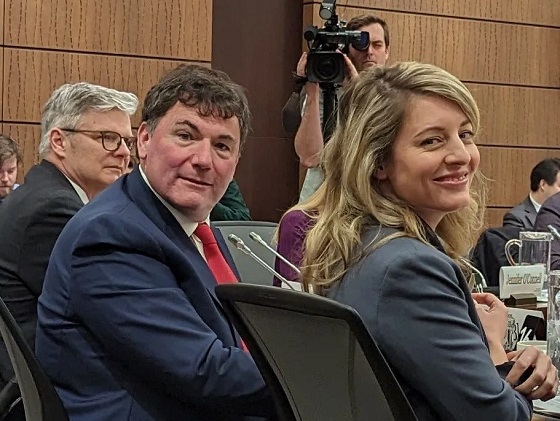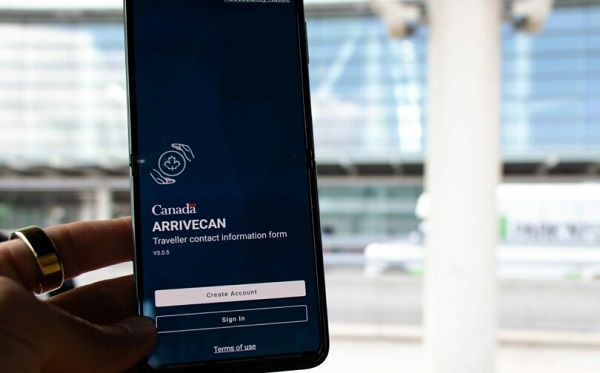National
It’s Been One Week

Imagine the relief they’re feeling. Photo from the voluminous PW files
Paul Wells
Hold it now and watch the hoodwink/ As I make you stop, think
Maybe the Americans assume we’re already part of their country because our leaders won’t get off their TV shows. Politico reports that Justin Trudeau’s office called Jen Psaki on Thursday morning and asked whether she’d interview Canada’s prime minister pro tem for her Sunday MSNBC political show. The PMO’s timing was excellent: Psaki was dropping a kid off at school, so she had excess childcare capacity at precisely the moment she was being offered quality time with somebody high-maintenance.
Trudeau had a message to deliver about Canada-US relations, and he was eager to deliver it to the seventh highest-rated show on MSNBC. He also paid his regards to Jake Tapper, who gets fully one-fifth the viewers of his Fox competitors.
Trudeau’s message to his tiny bespoke audiences was straightforward: that Donald Trump wants to talk about annexing Canada because he doesn’t want to talk about the economic costs of his own tariff policy. Trump’s advisors were said to be working this week on ways to limit those costs. Talk of costs isn’t guaranteed to change Trump’s mind, but nothing is. I don’t have a secret smarter policy I’m keeping in my back pocket; the situation is what it is. Danielle Smith went to Mar-a-Lago — a gambit as legitimate as Trudeau’s visit or anybody else’s — but didn’t come away sounding confident that she’d had better results than anyone else.
Even Stephen Harper — also appearing on a U.S. podcast — sounded worried and perplexed by Trump’s thinking. Still, Canada’s last Conservative prime minister delivered a rebuttal of Trump that was orders of magnitude more on-topic and specific than anything we’ve yet heard from the next Conservative prime minister. There’s playing tough, and then there’s being tough.
Today (Jan 14) is the last day to subscribe to this newsletter at my original rate of $5 a month or $50 a year. Tomorrow the rate goes up to $8 a month/ $80 a year. Anyone who subscribes at the lower rate will remain locked in at that rate for as long as they remain a subscriber.
Trudeau will do what he does until the Liberals select his successor. His itinerary for Tuesday says “No public events scheduled,” yet again. If he has any particular message for Canadians at T2 Minus Six Days, he is in no hurry to deliver it. I think something in him broke after the Toronto—St. Paul’s by-election defeat at the end of June. Sure, he’s talked to Mark Critch and the hot-sauce guy in Quebec. But the fight was out of him long before he made it official. The impulse in almost any politician to tell you exactly what they’re up to — the yearning François-Philippe Champagne has at triple strength — it’s all but vanished from Trudeau for months now. I don’t think it’s because he’s decided to resign. I think if he had managed to stare down his Liberal critics over the holidays, if he still had one more campaign ahead of him, he’d still basically be waiting. In that alternate universe, waiting for the voters to deliver their verdict.
Instead Trudeau let his party’s late-blooming internal opposition win, and now the Liberals are having a bad time of it. I have to assume that in some corner of his psyche, he enjoys seeing them squirm. All he wanted to do was receive the voters’ judgment. There would have been grim realism in letting him. But the Liberal caucus, docile in October, panicked and bolted in December after Chrystia Freeland quit. So now they get to come up with a better idea.
By 2021 or so, the people who’d left the Trudeau government started to look like a better cabinet than the ones who’d stayed. Similarly, a lot of the talent in the emerging Liberal leadership race is in the people who are sitting it out: Dominic LeBlanc, Anita Anand, Champagne, Mélanie Joly if you like. Steve MacKinnon would have been interesting to watch as an underdog. He speaks both official languages better than most MPs speak either, and after an early defeat in 2011, he reacted in the old-fashioned way: by figuring out how to get better at politics. Oh well.
Does anybody doubt the crew who aren’t running for the leadership will have a more pleasant 2025 than Mark Carney, Chrystia Freeland, Christy Clark, Karina Gould, Chandra Arya and That Other Guy? Frenzied parallel campaigns to raise money and recruit supporters. Gigantic questions they’d rather avoid. Party horse-race polls that have exited the realm of arithmetic and turned into Escher drawings. And waiting just over the horizon, cracking their knuckles: the voters of Canada.
Realistically it’ll come down to Freeland and Carney, if they both run. A study in contrasts: she’s from Alberta but couldn’t save her former chief of staff who ran in the riding next to Freeland’s last June. He’s from Alberta but has been flirting with electoral politics since the Obama presidency. “I’ve just started thinking about it,” Carney told Jon Stewart, whose return has driven The Daily Show to fully 40% of Colbert’s ratings. Just started thinking about it? Where’s he been all his life?
I wasn’t kidding, not one tiny bit, when I wrote last week that the least Carney can do is cough up the task force report on the economy that his party’s current leader commissioned from him four months ago. This should not seem like a clever gotcha from one of our nation’s premier snarky pundits. It should be obvious that serious people finish a job, and that the best measure of Carney’s insight and instincts is the work he was theoretically already doing when things got weird.
An obvious question for Freeland is why the Nanos polling spread between Liberals and Conservatives is seven points wider than it was the day before she left the cabinet. Another is whether the “costly political gimmicks” in the Fall Economic Statement she declined to deliver were the first she’d seen.
They’ve both done great things. Carney was appointed to run two central banks by two Conservative prime ministers, neither of whom ever had a word of criticism for his work. He delivered the smoothest possible Brexit even though he hated the idea. Freeland basically picked the Trudeau government up from the wrong side of relations with Russia and dropped it on the right side. Neither needs my permission to march into the history books. But if you think either is a natural political talent, you’ll find the next couple of months hard to watch.
Maybe one of the Liberal candidates will develop the habit of answering questions when asked. It would have the virtue of novelty. It worked well for Harper on that American podcast. Pierre Poilievre is still pivoting to message. Last week he was asked why Elon Musk seems to like him. “If I ever get a chance to meet Musk, I would say, how do we make this an economy where we bring home hundreds of billions of dollars of investment to Canada?” Smooth. Except Musk makes no secret of his answer: ban union labour. Which fits poorly with some of Poilievre’s pro-union marketing.
Two years ago three of Poilievre’s MPs met with Christine Anderson, a German eurodeputy from the AfD party. Poilievre called her views “vile” and said they “have no place in Canada.” Musk has been campaigning nearly full-time for Anderson’s party in German legislative elections.
I’m not trying to pin AfD’s politics on Poilievre. I’m just pointing out that once he no longer has Trudeau to kick around, the internal contradictions in Poilievre’s positions will become harder to ignore.
This week Jenni Byrne, Poilievre’s lead gatekeeper, came in for criticism when she criticized Erin O’Toole for saying nice things about Anita Anand. “For anyone unsure why Erin is no longer leader of the Conservative Party…. [Anand] supported DEI [diversity, equity and inclusion] policies like name, rank and pronouns. Tampons in men’s rooms, etc.” Much of the criticism amounts to dismay that Byrne could be so mean. I could hardly care less. But I do wonder where Byrne expects Canadian soldiers to fight, and alongside whom. Here’s a story on pronoun use in the U.S. Navy and Marines. Here’s one on the UK’s Ministry of Defence offering pronoun guidance while Boris Johnson was prime minister. Here’s NATO’s gender-inclusive language manual. When congratulating oneself on preferring a warrior culture to woke culture, it’s handy to have the first clue what’s going on in other warrior cultures.
Mostly I wonder how anyone could look at a Navy [UPDATE: That should read “Air Force” — pw] veteran congratulating a former Minister of Defence and think, before anything else, “But the tampons!” Poland, and Elon Musk’s friend Donald Trump, want member states in the woke NATO alliance to spend five percent of GDP on national defence. All of the Liberals and all of the Conservatives in all of Canada’s little schoolyard arguments have never come up with a plan to get to two. I know we all get excited about our little feuds, but after an election comes, whoever wins will have to provide real government for a real country in a real world. That’s harder than tweeting.
Subscribe to Paul Wells
Politics and culture as though they mattered.
Alberta
Punishing Alberta Oil Production: The Divisive Effect of Policies For Carney’s “Decarbonized Oil”

From Energy Now
By Ron Wallace
The federal government has doubled down on its commitment to “responsibly produced oil and gas”. These terms are apparently carefully crafted to maintain federal policies for Net Zero. These policies include a Canadian emissions cap, tanker bans and a clean electricity mandate.
Following meetings in Saskatoon in early June between Prime Minister Mark Carney and Canadian provincial and territorial leaders, the federal government expressed renewed interest in the completion of new oil pipelines to reduce reliance on oil exports to the USA while providing better access to foreign markets. However Carney, while suggesting that there is “real potential” for such projects nonetheless qualified that support as being limited to projects that would “decarbonize” Canadian oil, apparently those that would employ carbon capture technologies. While the meeting did not result in a final list of potential projects, Alberta Premier Danielle Smith said that this approach would constitute a “grand bargain” whereby new pipelines to increase oil exports could help fund decarbonization efforts. But is that true and what are the implications for the Albertan and Canadian economies?
The federal government has doubled down on its commitment to “responsibly produced oil and gas”. These terms are apparently carefully crafted to maintain federal policies for Net Zero. These policies include a Canadian emissions cap, tanker bans and a clean electricity mandate. Many would consider that Canadians, especially Albertans, should be wary of these largely undefined announcements in which Ottawa proposes solely to determine projects that are “in the national interest.”
The federal government has tabled legislation designed to address these challenges with Bill C-5: An Act to enact the Free Trade and Labour Mobility Act and the Building Canada Act (the One Canadian Economy Act). Rather than replacing controversial, and challenged, legislation like the Impact Assessment Act, the Carney government proposes to add more legislation designed to accelerate and streamline regulatory approvals for energy and infrastructure projects. However, only those projects that Ottawa designates as being in the national interest would be approved. While clearer, shorter regulatory timelines and the restoration of the Major Projects Office are also proposed, Bill C-5 is to be superimposed over a crippling regulatory base.
It remains to be seen if this attempt will restore a much-diminished Canadian Can-Do spirit for economic development by encouraging much-needed, indeed essential interprovincial teamwork across shared jurisdictions. While the Act’s proposed single approval process could provide for expedited review timelines, a complex web of regulatory processes will remain in place requiring much enhanced interagency and interprovincial coordination. Given Canada’s much-diminished record for regulatory and policy clarity will this legislation be enough to persuade the corporate and international capital community to consider Canada as a prime investment destination?
As with all complex matters the devil always lurks in the details. Notably, these federal initiatives arrive at a time when the Carney government is facing ever-more pressing geopolitical, energy security and economic concerns. The Organization for Economic Co-operation and Development predicts that Canada’s economy will grow by a dismal one per cent in 2025 and 1.1 per cent in 2026 – this at a time when the global economy is predicted to grow by 2.9 per cent.
It should come as no surprise that Carney’s recent musing about the “real potential” for decarbonized oil pipelines have sparked debate. The undefined term “decarbonized”, is clearly aimed directly at western Canadian oil production as part of Ottawa’s broader strategy to achieve national emissions commitments using costly carbon capture and storage (CCS) projects whose economic viability at scale has been questioned. What might this mean for western Canadian oil producers?
The Alberta Oil sands presently account for about 58% of Canada’s total oil output. Data from December 2023 show Alberta producing a record 4.53 million barrels per day (MMb/d) as major oil export pipelines including Trans Mountain, Keystone and the Enbridge Mainline operate at high levels of capacity. Meanwhile, in 2023 eastern Canada imported on average about 490,000 barrels of crude oil per day (bpd) at a cost estimated at CAD $19.5 billion. These seaborne shipments to major refineries (like New Brunswick’s Irving Refinery in Saint John) rely on imported oil by tanker with crude oil deliveries to New Brunswick averaging around 263,000 barrels per day. In 2023 the estimated total cost to Canada for imported crude oil was $19.5 billion with oil imports arriving from the United States (72.4%), Nigeria (12.9%), and Saudi Arabia (10.7%). Since 1988, marine terminals along the St. Lawrence have seen imports of foreign oil valued at more than $228 billion while the Irving Oil refinery imported $136 billion from 1988 to 2020.
What are the policy and cost implication of Carney’s call for the “decarbonization” of western Canadian produced, oil? It implies that western Canadian “decarbonized” oil would have to be produced and transported to competitive world markets under a material regulatory and financial burden. Meanwhile, eastern Canadian refiners would be allowed to import oil from the USA and offshore jurisdictions free from any comparable regulatory burdens. This policy would penalize, and makes less competitive, Canadian producers while rewarding offshore sources. A federal regulatory requirement to decarbonize western Canadian crude oil production without imposing similar restrictions on imported oil would render the One Canadian Economy Act moot and create two market realities in Canada – one that favours imports and that discourages, or at very least threatens the competitiveness of, Canadian oil export production.
Ron Wallace is a former Member of the National Energy Board.
Fraser Institute
Long waits for health care hit Canadians in their pocketbooks

From the Fraser Institute
Canadians continue to endure long wait times for health care. And while waiting for care can obviously be detrimental to your health and wellbeing, it can also hurt your pocketbook.
In 2024, the latest year of available data, the median wait—from referral by a family doctor to treatment by a specialist—was 30 weeks (including 15 weeks waiting for treatment after seeing a specialist). And last year, an estimated 1.5 million Canadians were waiting for care.
It’s no wonder Canadians are frustrated with the current state of health care.
Again, long waits for care adversely impact patients in many different ways including physical pain, psychological distress and worsened treatment outcomes as lengthy waits can make the treatment of some problems more difficult. There’s also a less-talked about consequence—the impact of health-care waits on the ability of patients to participate in day-to-day life, work and earn a living.
According to a recent study published by the Fraser Institute, wait times for non-emergency surgery cost Canadian patients $5.2 billion in lost wages in 2024. That’s about $3,300 for each of the 1.5 million patients waiting for care. Crucially, this estimate only considers time at work. After also accounting for free time outside of work, the cost increases to $15.9 billion or more than $10,200 per person.
Of course, some advocates of the health-care status quo argue that long waits for care remain a necessary trade-off to ensure all Canadians receive universal health-care coverage. But the experience of many high-income countries with universal health care shows the opposite.
Despite Canada ranking among the highest spenders (4th of 31 countries) on health care (as a percentage of its economy) among other developed countries with universal health care, we consistently rank among the bottom for the number of doctors, hospital beds, MRIs and CT scanners. Canada also has one of the worst records on access to timely health care.
So what do these other countries do differently than Canada? In short, they embrace the private sector as a partner in providing universal care.
Australia, for instance, spends less on health care (again, as a percentage of its economy) than Canada, yet the percentage of patients in Australia (33.1 per cent) who report waiting more than two months for non-emergency surgery was much higher in Canada (58.3 per cent). Unlike in Canada, Australian patients can choose to receive non-emergency surgery in either a private or public hospital. In 2021/22, 58.6 per cent of non-emergency surgeries in Australia were performed in private hospitals.
But we don’t need to look abroad for evidence that the private sector can help reduce wait times by delivering publicly-funded care. From 2010 to 2014, the Saskatchewan government, among other policies, contracted out publicly-funded surgeries to private clinics and lowered the province’s median wait time from one of the longest in the country (26.5 weeks in 2010) to one of the shortest (14.2 weeks in 2014). The initiative also reduced the average cost of procedures by 26 per cent.
Canadians are waiting longer than ever for health care, and the economic costs of these waits have never been higher. Until policymakers have the courage to enact genuine reform, based in part on more successful universal health-care systems, this status quo will continue to cost Canadian patients.







